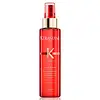What's inside
What's inside
 Key Ingredients
Key Ingredients

 Benefits
Benefits

 Concerns
Concerns

 Ingredients Side-by-side
Ingredients Side-by-side

Water
Skin ConditioningIsopropyl Myristate
EmollientIsododecane
EmollientDimethicone
EmollientVp/Va Copolymer
Magnesium Sulfate
Phenoxyethanol
PreservativeChlorphenesin
AntimicrobialCaprylyl Glycol
EmollientCocos Nucifera Oil
MaskingEthylhexyl Salicylate
UV AbsorberBenzyl Alcohol
PerfumingOrbignya Oleifera Seed Oil
EmollientTocopherol
AntioxidantCitric Acid
BufferingCI 19140
Cosmetic ColorantCI 17200
Cosmetic ColorantSodium Hydroxide
BufferingParfum
MaskingWater
Skin ConditioningButylene Glycol
HumectantGlycerin
HumectantArgania Spinosa Kernel Oil
EmollientHelianthus Annuus Seed Extract
Skin ConditioningCarrageenan
Parfum
MaskingPEG-40 Hydrogenated Castor Oil
EmulsifyingXanthan Gum
EmulsifyingSilicone Quaternium-22
PPG-26-Buteth-26
Skin ConditioningHydroxyacetophenone
AntioxidantBenzophenone-4
UV AbsorberCaprylyl Glycol
EmollientDipropylene Glycol
HumectantPolyglyceryl-3 Caprate
EmulsifyingCitric Acid
BufferingCocamidopropyl Betaine
CleansingCarnosine
Skin ConditioningPalmitamidopropyltrimonium Chloride
Propylene Glycol
HumectantSd Alcohol 40-B
AstringentBenzophenone-3
UV AbsorberC12-13 Pareth-9
EmulsifyingCaprylic/Capric Triglyceride
MaskingErgothioneine
AntioxidantAlgin
MaskingChitosan
Coco-Glucoside
CleansingSorbitan Oleate
EmulsifyingGuar Hydroxypropyltrimonium Chloride
Skin ConditioningCetrimonium Chloride
AntimicrobialChlorphenesin
AntimicrobialSodium Benzoate
MaskingPotassium Sorbate
PreservativePhenoxyethanol
PreservativeAlpha-Isomethyl Ionone
PerfumingLinalool
PerfumingWater, Butylene Glycol, Glycerin, Argania Spinosa Kernel Oil, Helianthus Annuus Seed Extract, Carrageenan, Parfum, PEG-40 Hydrogenated Castor Oil, Xanthan Gum, Silicone Quaternium-22, PPG-26-Buteth-26, Hydroxyacetophenone, Benzophenone-4, Caprylyl Glycol, Dipropylene Glycol, Polyglyceryl-3 Caprate, Citric Acid, Cocamidopropyl Betaine, Carnosine, Palmitamidopropyltrimonium Chloride, Propylene Glycol, Sd Alcohol 40-B, Benzophenone-3, C12-13 Pareth-9, Caprylic/Capric Triglyceride, Ergothioneine, Algin, Chitosan, Coco-Glucoside, Sorbitan Oleate, Guar Hydroxypropyltrimonium Chloride, Cetrimonium Chloride, Chlorphenesin, Sodium Benzoate, Potassium Sorbate, Phenoxyethanol, Alpha-Isomethyl Ionone, Linalool
Ingredients Explained
These ingredients are found in both products.
Ingredients higher up in an ingredient list are typically present in a larger amount.
Caprylyl Glycol is a humectant and emollient, meaning it attracts and preserves moisture.
It is a common ingredient in many products, especially those designed to hydrate skin. The primary benefits are retaining moisture, skin softening, and promoting a healthy skin barrier.
Though Caprylyl Glycol is an alcohol derived from fatty acids, it is not the kind that can dry out skin.
This ingredient is also used as a preservative to extend the life of products. It has slight antimicrobial properties.
Learn more about Caprylyl GlycolChlorphenesin is a synthetic preservative. It helps protect a product against bacteria in order to extend shelf life. In most cases, Chlorphenesin is paired with other preservatives such as phenoxyethanol and caprylyl glycol.
Chlorphenesin is a biocide. This means it is able to help fight the microorganisms on our skin. It is also able to fight odor-releasing bacteria.
Chlorphenesin is soluble in both water and glycerin.
Studies show Chlorphenesin is easily absorbed by our skin. You should speak with a skincare professional if you have concerns about using Chlorphenesin.
Learn more about ChlorphenesinCitric Acid is an alpha hydroxy acid (AHA) naturally found in citrus fruits like oranges, lemons, and limes.
Like other AHAs, citric acid can exfoliate skin by breaking down the bonds that hold dead skin cells together. This helps reveal smoother and brighter skin underneath.
However, this exfoliating effect only happens at high concentrations (20%) which can be hard to find in cosmetic products.
Due to this, citric acid is usually included in small amounts as a pH adjuster. This helps keep products slightly more acidic and compatible with skin's natural pH.
In skincare formulas, citric acid can:
While it can provide some skin benefits, research shows lactic acid and glycolic acid are generally more effective and less irritating exfoliants.
Most citric acid used in skincare today is made by fermenting sugars (usually from molasses). This synthetic version is identical to the natural citrus form but easier to stabilize and use in formulations.
Read more about some other popular AHA's here:
Learn more about Citric AcidParfum is a catch-all term for an ingredient or more that is used to give a scent to products.
Also called "fragrance", this ingredient can be a blend of hundreds of chemicals or plant oils. This means every product with "fragrance" or "parfum" in the ingredients list is a different mixture.
For instance, Habanolide is a proprietary trade name for a specific aroma chemical. When used as a fragrance ingredient in cosmetics, most aroma chemicals fall under the broad labeling category of “FRAGRANCE” or “PARFUM” according to EU and US regulations.
The term 'parfum' or 'fragrance' is not regulated in many countries. In many cases, it is up to the brand to define this term.
For instance, many brands choose to label themselves as "fragrance-free" because they are not using synthetic fragrances. However, their products may still contain ingredients such as essential oils that are considered a fragrance by INCI standards.
One example is Calendula flower extract. Calendula is an essential oil that still imparts a scent or 'fragrance'.
Depending on the blend, the ingredients in the mixture can cause allergies and sensitivities on the skin. Some ingredients that are known EU allergens include linalool and citronellol.
Parfum can also be used to mask or cover an unpleasant scent.
The bottom line is: not all fragrances/parfum/ingredients are created equally. If you are worried about fragrances, we recommend taking a closer look at an ingredient. And of course, we always recommend speaking with a professional.
Learn more about ParfumPhenoxyethanol is a preservative that has germicide, antimicrobial, and aromatic properties. Studies show that phenoxyethanol can prevent microbial growth. By itself, it has a scent that is similar to that of a rose.
It's often used in formulations along with Caprylyl Glycol to preserve the shelf life of products.
Water. It's the most common cosmetic ingredient of all. You'll usually see it at the top of ingredient lists, meaning that it makes up the largest part of the product.
So why is it so popular? Water most often acts as a solvent - this means that it helps dissolve other ingredients into the formulation.
You'll also recognize water as that liquid we all need to stay alive. If you see this, drink a glass of water. Stay hydrated!
Learn more about Water